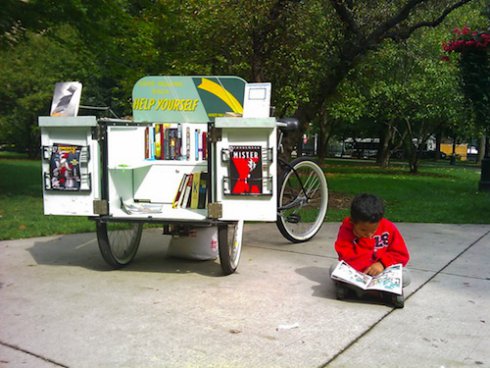
Click for more info.
Okay, this is a bit of a cheat, because it involves friend of Murketing Gabriel Levinson, but I have to throw The Book Bike into this series. And in a way, it fits perfectly. Here’s some info:
Everyone has the right to build and cherish a private library.
With this in mind, we present The Book Bike: a custom-built tricycle stocked with 200 lbs of free books. Since July of 2008, The Book Bike has been responsible for placing over 3,000 new and used books into peoples’ hands. In spring and summer, you’ll find The Book Bike at Chicago public parks on the weekends; anyone who wants a book is invited to take something home to read.
In the summer of 2010, The Book Bike puts a spotlight on independent publishers: from hand-crafted zines to literary magazines and books, The Book Bike is a unique resource of the global independent literary scene….
More here. Oh, and if you’re in Chicago and encounter the Book Bike: I’ll be donating some back issues (2008 and 2007) of my annual zine, Where Were You?
Posted Under:
Pleasing
This post was written by Rob Walker on May 6, 2010
Comments Off on Books, the idea, cont’d: The Book Bike
Thanks, everybody, for making confessing everything on Facebook seem so normal. Despite “connecting” us more securely with others online, social networking has made our real-life, non-online identities more insecure than ever. With a new tool to investigate what we don’t immediately disclose up front, there is less reason for anyone to take us at face value. I guess people just Google us while nodding along and ignoring what we say.
This long excursus at n+1 makes a similar point about targeted ads pinpointing our place on what Facebook calls the social graph: “Today we Google ourselves to see what the world knows about us; tomorrow we’ll just watch the ads.” And to take the idea to its logical conclusion: we will eventually Google ourselves to find out who we are.
Shortly after reading that enjoyable Marginal Utility passage — and particularly enjoying the line, “we will eventually Google ourselves to find out who we are” — I encountered this Slate item which promised to evaluate the ideological content of my “news diet” by assessing my browsing history. It’s not quite Googling the self to discover the self, but it’s on the right track. I gave it a whirl!
The tool scanned whatever it scans and promptly informed me: “At these sites, the readership is on average 49 percent conservative, 51 percent liberal.” Also: “Your isolation index is -31, meaning that, on the bell curve of all readers, your news diet is 31 percentage points to the left.” I don’t know what that latter bit means, and this “interactive test” is sort of based on and spun off a recent study that’s gotten a lot of attention for its assertion that news consumption online isn’t as ideologically isolationist as people assume. (The study seems to me to have been undertaken precisely to reach this “surprising” conclusion, and is full of caveats that make it, to me, totally meaningless.)
The Slate item further point to some other site, where there’s a similar setup that’s meant to deduce your gender from your browser URL history. I did that too. Result:
Likelihood of you being FEMALE is 63%
Likelihood of you being MALE is 37%
Hm. Well, I guess it’s still to early to deduce who I am by asking the Internet.
(Or… is it?)
Anyway, the Marginal Utility post cited above is much less frivolous than this little exercise, and worth reading.
 Well, funny you should ask! It’s a special issue on sustainable consumption and production, and there’s a review by me of an interesting book called Shopping Our Way to Safety, by Andrew Szasz, who makes great points about what he calls “inverted quarantine” — basically the (futile, he argues convincingly) idea that we can insulate ourselves from various ecological problems simply through individual consumption habits. I think you can read the review here.
Well, funny you should ask! It’s a special issue on sustainable consumption and production, and there’s a review by me of an interesting book called Shopping Our Way to Safety, by Andrew Szasz, who makes great points about what he calls “inverted quarantine” — basically the (futile, he argues convincingly) idea that we can insulate ourselves from various ecological problems simply through individual consumption habits. I think you can read the review here.
To my surprise, the issue also includes a nice review of Buying In.
I haven’t yet read any of the articles, but much of the issue looks promising. The introduction provides a kind of roadmap to what else is included.
Posted Under:
Consumer Behavior,
rw
This post was written by Rob Walker on May 6, 2010
Comments Off on What’s in the Jan/Feb issue of the Journal of Industrial Ecology?
When I first saw these via Junk Culture, I thought it was something I’d covered previously in this series. But now I think not — I believe I was thinking of the Brian Dettmer work noted here. This is a different artist, Alexander Korzer-Robinson, making Book Objects:

"Development of the Human Heart," Click for more.
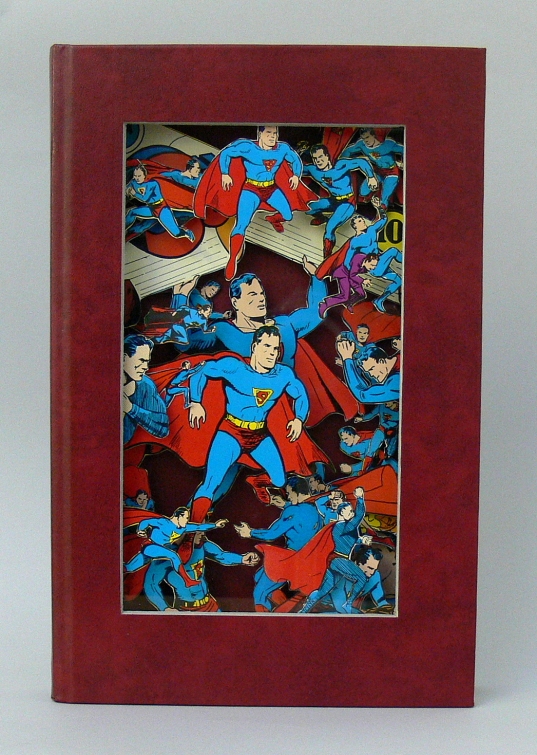
"To The Rescue," Click for more.
Posted Under:
Artists
This post was written by Rob Walker on May 6, 2010
Comments Off on Books, the idea: Sculpture-objects
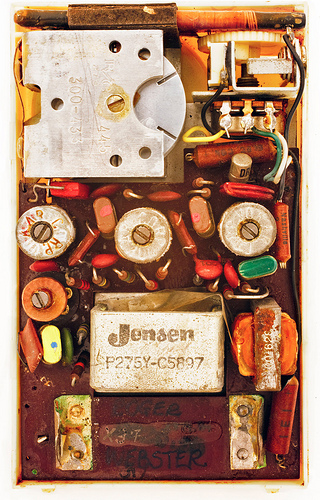
by Mark Richards; click for more.
Part of a series.
Posted Under:
Artists
This post was written by Rob Walker on May 5, 2010
Comments Off on Pictures of stuff, cont’d: Radio innards
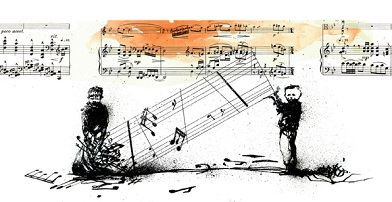
Illustration by Jeremy Traum; click for more on the first seven interpretations.
This month’s Atlantic includes a piece by Megan McArdle called The Freeloaders: How a generation of file-sharers is ruining the future of entertainment. It struck me as a rather retro argument at this late date, but Marc Weidenbaum over at Disquiet had a more interesting response. He critiques the essays specific points here. Even better than his written reply, however, is the musical one that he proceeded to curate.
Marc (a greatly respected friend) took particular issue with McArdle’s matter-of-fact equation of the fate of “the music industry” with the fate of music, which struck him as a non-contribution to the important discussion of copyright and culture in the digital era. He figures there has been, and will continue to be, plenty of worthwhile music made whether or not the present major record labels figure out profitable business models. Now, it’s easy to say that — but Marc did something specific to make his point. Noting that the piece was accompanied by an illustration that happens to incorporate a musical score (above), he invited musicians to compose new interpretations of the illustration. So far seven have done so — for free — and Marc has posted those on his site — also for free. It adds up to 55-minute musical response. Give it a listen here.
He has also has an open call out for more musical interpretation/responses; contact on Disquiet.com.
Posted Under:
Backlashing,
Music
This post was written by Rob Walker on May 5, 2010
Comments Off on A musical rebuttal to an Altlantic piece about “freeloaders”
While I thought a book vending machine was a strange one-off from the past, Steve Portigal sets me straight with this pic he took at Heathrow just last November:
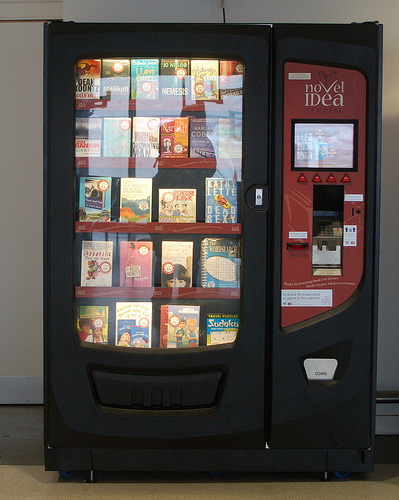
Pic by Steve Portigal, click for more.
This post is part of an occasional series.
Posted Under:
Things/Thinking
This post was written by Rob Walker on May 5, 2010
Comments Off on Books, the idea: Contemporary vending machine example
Over at Hilobrow, Matthew Battles makes an interesting point about ROFLCon. (Well, he makes several, but I’m only going to address one of them here. Read his whole writeup here.) In the panels he attended, he notes: “Too often the tone was, ‘turn your snarky web site into a book — or even a TV show!'”
There’s a lot of truth in that — many of the meme-makers and Internet celebs and other proprietors of what was being celebrated as outsider weirdness got a hearty round of applause upon noting their recent book deal or other cash infusion from the trad media. This is interesting in part because it suggests that if there’s a ROFL subculture, it’s not exactly standing in opposition to the fabled MSM, despite rhetoric to the contrary. (Surely this relates to my uncertainty about what that ROFLCon attendee was getting at with her accusatory “Seriously? The New York Times?” blurtage.)
To be fair, there were also stories of turning away MSM overtures that were particularly insipid, and more than one ROFLmaker seemed to take the attitude that they were better off going with a more autonomous monetization strategy (selling ads, selling merch direct to fans, etc.). The point is that I’m not sure if MSM represents a sanctifying force in ROFLCulture — or simply a source of ready money. (Money that ROFLmakers may see as a no more than a dumb windfall.) Or some of each.
Too many links. This is what happens when I skip a linkpile post. Sorry.
- Top Executive Declares That NYT, Using Personal Data, Must Turn Its Readers Into “Leverageable Assets.”: “Identity is, in my view, a fundamental building block for engagement.”
- Promiscuous online culture and the vetting process: “At the intersection of promiscuous online culture and easy access to search lies a world where it’s impossible to hide. And these days, you look suspicious for trying, or even forgetting something innocently.” I agree with Marginal Utility — this post describes a terrifying drift.
- The Safety of Objects: Design and “Inverted Totalitarianism”: “A symptomatic reading of Objectified reveals an urge for impeccable order, an incurable desire to purge from public view the irregular, the odd, the heteroclite, and even the excessively ornate or strictly utilitarian, in order to place in their stead a whole array of everyday things boasting clean lines and soothing orbicularities — a regime of Platonic functionality, in other words, vouchsafed to an auxiliary of designers equipped with the latest drafting software and laser-guided precision instruments. Objectified comes across as a fever dream of the sort which brings the sufferer visions of the world to come: namely, the dictatorship of the creative class.”
- Some Twitter data: 87 percent of Americans are aware of it. 7 percent use it. Facebook has similar awareness, six times as many users. Just over half of Twiter users don’t tweet, they just treat it as “broadcast content.” 24 percent of Twitter users are African American.
- Costco prank: Shopdrop variation: Shelf tags for fictional objects stuck in Costco. Okay.
- Los Angeles Times Adds Paid Links in Articles – Media Decoder Blog – NYTimes.com: “These post-publication links to sites such as Amazon and TicketNetwork will serve as both a reader service and a revenue opportunity for the company.” Via PSFK.
- When multi-tasking, each half of the brain focuses on different goals | Not Exactly Rocket Science | Discover Magazine: Researchers “have found that the part of our brain that controls out motivation to pursue our goals can divide its attention between two tasks. The left half devotes itself to one task and the right half to the other. This division of labour allows us to multi-task, but it also puts an upper limit on our abilities.” Didn’t we know this already?
- The Evolution of Advertising in Sports Video Games: From 1983 to 2006.
- Play’s the Thing: “A new book argues that play may be the primary means nature has found to develop our brains.”
These links compiled via delicious, and repurposed here with plug-in Postalicious. Not enough stuff? Not the stuff you wanted? Try visiting unconsumption.tumblr.com, murketing.tumblr.com, and/or the Consumed Facebook page.
Posted Under:
Non-Daily Linkpile
This post was written by Rob Walker on May 4, 2010
Comments Off on (0verflowing) Linkpile
These stress balls…
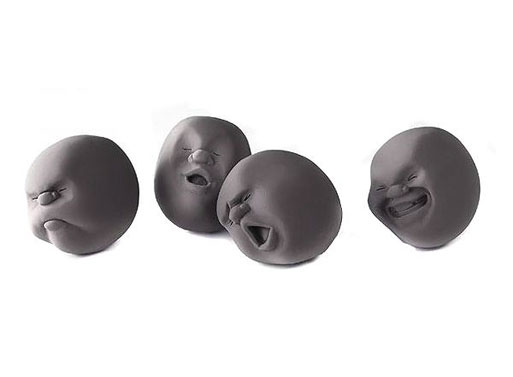
$152; click for more.
… remind me of the Makapansgat Pebble (discussed here):

The Birth of Want. Click for more.
Posted Under:
The Designed Life,
Things/Thinking
This post was written by Rob Walker on May 3, 2010
Comments Off on Stress ball with (really, really) old-school aesthetic
Following up this post, and this one, another take on the stand-by color bars pattern:
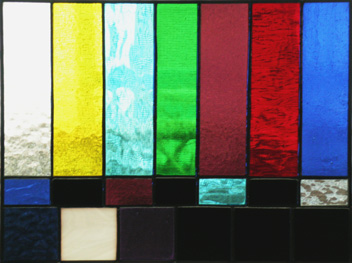
Stained Glass Test Pattern on Make site; click for more.
Nice!
Posted Under:
Pleasing,
The Designed Life
This post was written by Rob Walker on May 3, 2010
Comments Off on Stand by, continued
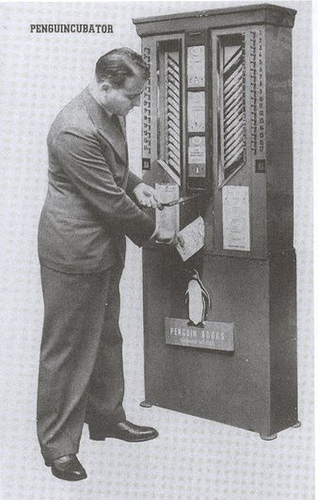
Penguincubator. Click for more.
This made the rounds recently, I believe originating with this piece on Publishing Perspectives, about Allen Lane, best known for devising the first breakout success cheap-but-quality paperback, for Penguin. Evidently Lane also dreamed up the device above: The Penguincubator, a book vending machine from the mid 1930s.
First installed outside Henderson’s (the “Bomb Shop”) at 66 Charing Cross Road, [it] signaled [Lane’s] intention to take the book beyond the library and the traditional bookstore, into railway stations, chain stores and onto the streets. It is worth noting, given publishers’ frequent timidity in this area, that this really annoyed booksellers. (Lane’s lack of trepidation is an important part of this story; worth noting, too, that he was the first English publisher of James Joyce’s Ulysses, at the Bodley Head, despite the widespread contemporary fear of prosecution for obscenity.)
In the Penguincubator we see several desires converge: affordable books, non-traditional distribution, awareness of context, and a quiet radicalism. And it’s not a huge leap of the imagination to see how these apply now. I see the same bored gaze on the bus and tube today, as people reflexively flip open their phones and start poking at email or casual games, as Allen Lane saw on the platform at Exeter in 1933. And slowly — oh, so slowly — publishers are seeing that what we are presented with is not the death of everything we trust, value and hold dear, but a similar widening vista of opportunity to that which arrived with the mass-market paperback.
I couldn’t find out much more — like the fate of this fascinating object — but there was another picture of it on Flickr, situated next to a “Bikini Automat.”
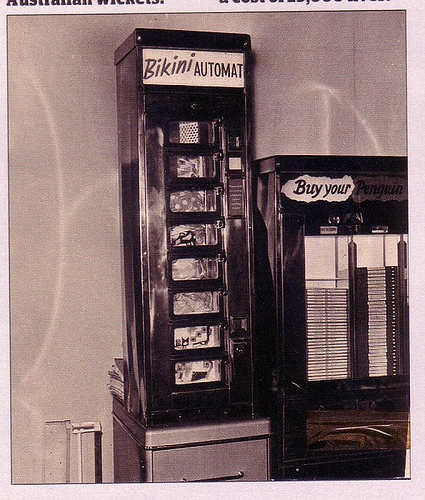
From Flickr user Mags. Click for more.
This site was quiet the last couple of days because I was out of town, attending ROFLCon. If you’re not familiar with this event, it’s devoted to Internet memes, Internet celebrity, weird online culture & phenomena, etc. The guest list here.
I’m not big on conferences, but obviously this one is … unusual. And I had a great time. Among other things I got to meet a couple of people I’ve written about in the past. One was imaginary brand impresario Pete Hottelet, who has the coolest business card I’ve ever seen, and who in general turned out to be a really nice, smart, and fascinating guy. I interviewed him via phone a while back in a column about Brawndo; he’s now also putting out the real-world version of Tru Blood, and will soon release another defictionalized product that I’ll write up here later. The other was Jef Sewell, one of the founders of Despair.com (I wrote about that here), who had some really great stuff to show off, including the company’s lavish new edition of Charles Ponzi’s memoir.It looks rather impressive; I think Sewell and his brother Justin have one of the most interesting businesses around.
I also got to meet a bunch of people I’ve interviewed for stuff that’s forthcoming, plus see some old friends, meet some new friends, and so on. There were several really good panels, and I have one or two thoughts from those that I’ll try to articulate here soon.
Anyway I also had one really weird moment, which I guess isn’t too surprising at this sort of event. Everybody had lanyard name tags on and of course mine said “New York Times” on it, because, you know, even though I’m not on staff, that’s my main client or venue or whatever you want to call it. I usually don’t think about this very much, but as I was leaving one panel, a young woman walking past me as she exited looked at my name tag and blurted out an incredulous: “Seriously?? You write for The New York Times?”
She sounded sort of appalled, or maybe alarmed, and possibly just a little bit hostile.
I had no idea what to say. Partly because I wasn’t sure what she meant. Was there something really unlikely about me, as a physical human being, writing for the Times? Or did her incredulity have to do with the idea that someone from The Times might be attending this event? If the latter, was she appalled that The Times would devote attention to stuff that’s so silly/weird/obscure? Or was it more like, “Oh what a bummer that the Times is here to ruin our cool subculture”? Again: I didn’t know what to say. Of course I’ve already written about several of the guests here, and I’ve interviewed many others. I’m sure the Times in general has covered many others. Basically I was so startled, but her tone more than anything, that I just stood there, mute.
And she kept walking. So that was that.
ROFL?
 UNIFORMITY
UNIFORMITY
The retailing of a representation of a faux-authentic uniform
In March, Burton Snowboards announced that later this year it would begin selling pants similar to those worn by the U.S. Olympic snowboarding team. There is a logic to this move, because the most notable thing about the team’s uniform was how much it looked like a trendy retail product….
Read the column in the May 2, 2010, New York Times Magazine, or here.
Discuss, make fun of, or praise this column to the skies at the Consumed Facebook page.
Posted Under:
Consumed
This post was written by Rob Walker on May 3, 2010
Comments Off on In the NYT Magazine: Burton’s Olympic pants go retail




 "
"












 UNIFORMITY
UNIFORMITY











 Kim Fellner's book
Kim Fellner's book  A
A